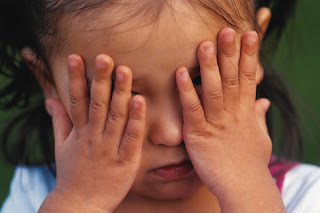
This week I'm taking a detour from my usual topic of the
Baby Signs Program to talk about a topic from
Baby Hearts, the third parenting book I co-authored with Dr. Susan Goodwyn--the development of embarrassment.
If there’s a 2-year-old at your next family get-together , it’s likely that at one time or another everyone will be laughing at something amusing she has done. Maybe she is busily eating chocolate cake, getting more around her mouth than in it, or maybe she is carefully trying to walk in her mother’s high heels. Whatever the behavior, as soon as the child becomes aware that she is the focus of attention she becomes upset. And no matter how many times she is reassured that no one is laughing at her, she remains inconsolable and is too embarrassed to continue.
Where does such embarrassment come from? Has some humiliation in the child’s past created an expectation of punishment or shame? Probably not. According to developmental researcher, Dr. Michael Lewis, such reactions are typical of children starting between 18 and 24 months. It’s at this age that children begin to experience embarrassment when they find they are the center of attention. It’s not that they think they’ve done anything wrong or shameful. It’s just that everyone is looking at them and it makes them extremely uneasy.
Why does such self-consciousness begin between 18 and 24 months? It’s quite simple. This is the age when toddlers first become aware of themselves as separate from other people, knowledge that is obviously critical to feeling embarrassed. In fact, Lewis demonstrated a direct connection between self-awareness and embarrassment in the following way.
First, he tested a group of toddlers to see if they could recognize themselves in a mirror – a classic test of self-awareness. The way to do this is to surreptitiously dab a spot of rouge on a child’s nose, set him in front of a mirror, and watch to see if he touches his nose. If he does, then it’s clear that he recognizes that the red spot on the nose in the mirror is a red spot on his own nose. Some the toddlers in Lewis study did touch their noses, while others did not.
Lewis then tested whether these same children would show embarrassment. He had their mothers urge them to dance in front of the experimenter to the sound of a tambourine. As you might expect, some children did so without hesitation while others refused, showing classic signs of embarrassment. Every one of these latter children, and very few of the former, were among those able to recognize themselves in a mirror, a lovely demonstration that the child’s developing mind and the child’s developing emotions are closely related.
Apparently the novelty of understanding that one is the center of attention is very unnerving. Whether or not there is a judgment involved is irrelevant; the child simply wants the attention itself to stop…now. The more mature understanding that one has done something that has violated some kind of standard of behavior won’t develop for another year or so. In the meantime, realizing that it’s the attention itself that toddlers dislike can help parents be more sympathetic. After all, would you want everyone watching you stuff chocolate cake into your mouth? I thought not.
Happy Signing (and don’t forget to follow us on Facebook)!
Linda
Linda Acredolo, Ph.D.
Co-Founder, the
Baby Signs Program
and
Professor Emeritus, UC Davis







